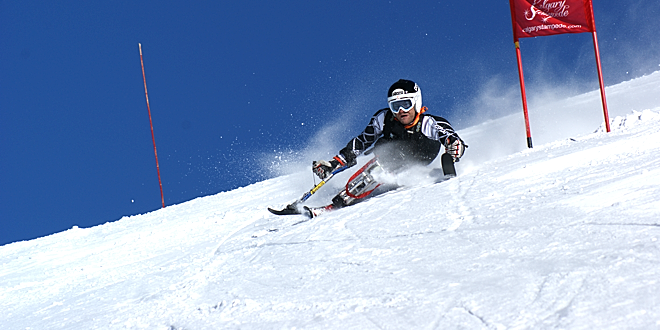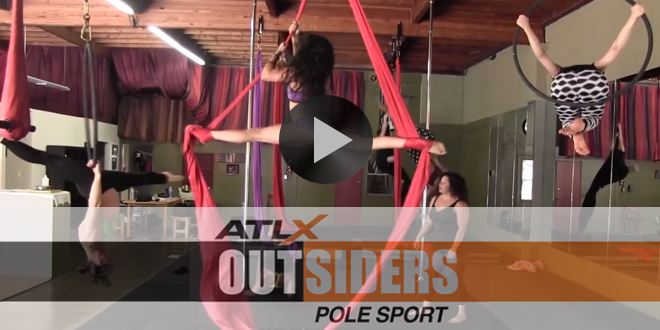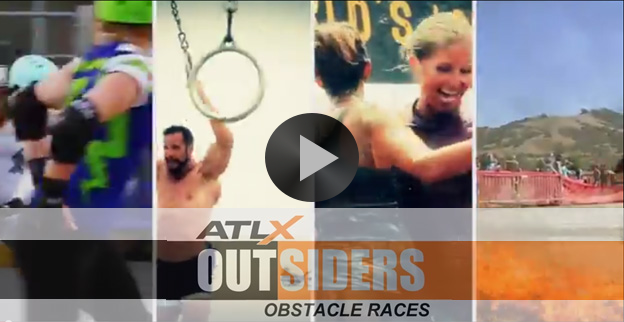By: Aaron Fischman
Most kids growing up in Franconia, N.H., like to ski in the winter, and Tyler Walker was no exception even though he’s been a double-amputee since the age of four. Tyler was born with a condition called lumbar sacral agenesis, meaning he has no lumbar vertebrae or sacrum.
As a result, his legs didn’t develop properly, and his parents ultimately decided to have his legs amputated at the knee.
“To make life easier, so I could get around more easily,” said Walker.
Still, everyone seemed to be skiing, including his friends, so a young Tyler pestered his parents until he was allowed to join his friends on the slopes. That’s not to say that he needed to be that forceful. According to Walker, his parents have been extremely supportive throughout his journey from a little boy wanting to ski to an accomplished Paralympian skier and ski racer. “They would drive me to and from the hill, and (they) fund(ed) me for a long time,” he recalled. “They were super awesome.”
Tyler’s dad went to great lengths to ensure that his son was skiing like the rest of the kids. First, it was a “sketchy” contraption he built his son out of a plastic sled, cross country skis and levers with metal spikes. A few years later, he bought Tyler a snowboard, put a plastic seat over it and had Tyler sit down while leaning over and dragging his hand on the snow.
 Considering such early creativity and innovation employed by Tyler’s father, it’s not much of a surprise that his current Paralympic skiing coach, Kevin Jardine, sees similar qualities in Tyler. “He’s quite a thinker,” said Jardine. “He plans, and he’s always coming up with new ideas and finds ways to follow through.”
Considering such early creativity and innovation employed by Tyler’s father, it’s not much of a surprise that his current Paralympic skiing coach, Kevin Jardine, sees similar qualities in Tyler. “He’s quite a thinker,” said Jardine. “He plans, and he’s always coming up with new ideas and finds ways to follow through.”
In that sense, skier and coach are of the same mind, according to Jardine: “We definitely, in a lot of ways, think the same way. The strategy we use is more of a trial and error. So I’ll suggest, ‘Hey, let’s try this and see how it goes,’ and he’s willing to do that. And one on one, we work really closely, really well together and we’ve made some key discoveries about his skiing just by experimenting with different things, whether it’s his equipment or his technique or whatever it is.”
Walker maintained that in order to achieve sustained success, one cannot be happy with the status quo. He described the quality as a “burning desire to always want to improve.” He added, “I don’t want to settle in. If I get comfortable, then I start thinking about, ‘I’m fast now, but can we go faster?’ Then, once you have the opportunity to try new things, you have to actually apply them.”
According to Walker, it’s so difficult to implement new advice or apply new techniques because with skiing, there’s not much time to think and the margin for error is incredibly slim.
“In ski racing if you make a mistake, like if you’re a little bit too wide on the gate or you lose your edge briefly and you lose a couple tenths of a second, your day’s over; you’ve just lost the race,” explained Walker. For that reason, Walker has trained himself to be able to change his technique and “mental state” during and in between runs.
When Tyler was 8 years old, after years of building makeshift equipment, his family discovered Adaptive Ski Programs New Hampshire, which is catered to skiers with disabilities. Through these programs, he learned how to use a bi-ski and eventually graduated to a mono-ski by the time he was 12.
Before he switched to the mono-ski, Tyler needed help getting around. The upgrade in equipment, however, made him much more independent, which was important for Tyler.
 “One of the coolest things was it’s like strapping on a pair of legs in a way,” said Walker. “All of a sudden when I go skiing with my friends, I can keep up and I can go where they’re going. It was tremendously liberating.”
“One of the coolest things was it’s like strapping on a pair of legs in a way,” said Walker. “All of a sudden when I go skiing with my friends, I can keep up and I can go where they’re going. It was tremendously liberating.”
The new equipment, which included a shock absorber, also allowed Tyler to take bigger jumps and go much faster.
Since Walker switched to mono-skis, he’s gone through a number of different types. As the relatively new mono-ski technology (mono-skis have been around for only about 30 years) has improved, Walker and his coaches continue to be on the lookout for whatever will make him the best and fastest skier possible.
“We figured out what frame geometries work best, what shocks work best (and) how to mount them in the frame,” detailed Walker.
Despite (or maybe because of) the fact that none of the U.S. Paralympic Ski coaches have disabilities, the team’s system has worked extremely well. The adaptive skiers, who are sitting down on their mono-skis, aim to adopt the same techniques able-bodied individuals would use on two legs.
“With each athlete’s disabilities, they’re trying to adapt to ski as close to an able-bodied skier as they can,” said Jardine. “So being an able-bodied person, I can demonstrate what an able-bodied person would do in a situation, and then we have to figure out together how to adapt that technique to what each athlete’s disability is.”
Jardine has been teaching adaptive skiing for nearly two decades, while he’s coached Walker for almost half that period of time.
“It’s like every time we go skiing, I learn something profound or he helps me fix some glaring mistake I didn’t always realize,” said Walker of his coach. “With being coached, there’s often a disconnect between what the coach is telling you and how you’re supposed to apply it when you’re actually skiing.”
But with Jardine, the fuzziness is greatly minimized because of Jardine’s years of coaching experience, as well as the two’s like-minded approach. Even so, not everything a stand-up skier can execute is physically possible on a mono-ski.
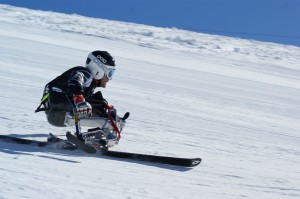 “It doesn’t work like legs,” emphasized Walker. “It tries to replicate legs, but it can’t completely, so you’re often at the mercy of the technology. You can set it up in all sorts of ways, but you can only go as fast as the technology will let you.”
“It doesn’t work like legs,” emphasized Walker. “It tries to replicate legs, but it can’t completely, so you’re often at the mercy of the technology. You can set it up in all sorts of ways, but you can only go as fast as the technology will let you.”
In skiing and ski racing, whether one has a disability or not, there is a considerable risk of injury.
“We’re going freeway speeds without a safety belt, so a lot of interesting things can happen,” said Walker, who further noted that for adaptive skiers who are sitting down, knee injuries so commonly found in runners, football players and even stand-up skiers are replaced by injuries to the shoulder area.
Injuries to the shoulder are most common because the shoulder is often the first body part to hit the snow in a crash. Such contact can result in a variety of injuries including torn rotator cuffs, separated shoulders and broken collarbones.
Despite these risks, a sit-down skier is not a sitting duck. (S)he can be proactive in reducing such risks by working out and strengthening those muscles. With that in mind, Walker has access to the Olympic Training Center in Colorado Springs, Colo., where he and adaptive teammates must cater workouts to their ability level. Personally, he likes to do rotator cuff exercises.
“We try to build up muscle mass there so that we can take a really hard hit. Sometimes we get up to mid-70 miles an hour and then crash into a fence, so we have to be able to withstand that kind of abuse.”
Walker considers himself lucky. While he often strains his shoulders from crashes or mere overuse, he has never incurred any really serious damage. Part of the reason for that may lie in his strong shoulders and arms. He’s always walking on them or using them to operate his wheelchair.
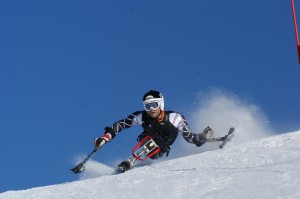 Although the constant use of his arms and shoulders builds immense strength, there’s no getting around their overuse, as he can’t realistically stop using them. As a result, Walker suffers from chronic and nagging pains that aren’t much different from those any other elite athlete experiences.
Although the constant use of his arms and shoulders builds immense strength, there’s no getting around their overuse, as he can’t realistically stop using them. As a result, Walker suffers from chronic and nagging pains that aren’t much different from those any other elite athlete experiences.
Developing the core is paramount to maintaining a race-ready body, according to Walker. “Upper body strength is good, but if you have a weak core you won’t be able to do anything,” he said.
Walker likes to do different exercises on a yoga ball. For instance, he simulates turns on it. Without being strapped in by a seatbelt, his ability to balance is challenged, enabling him to build core muscle. It also replicates the motions that he goes through while making a turn.
Being a Paralympian, as one might imagine, entails a grueling schedule. In fact, Walker has just one month off (May) all year.
When asked if skiing and ski racing has taken over his life, he answered quickly, “Yes, it does. Usually in a good way, but to be competitive at this level, it has to be a full-time job.”
Walker isn’t skiing seven days a week year-round, but every day is dedicated to some aspect of skiing, whether it’s actual skiing, reviewing video footage, working on nutrition or fine-tuning strategy and the mental part of Walker’s game.
Walker’s schedule between November and April is especially hectic, because he’s traveling virtually all the time.
Tyler joined the national team when he was 18 years old. During his time at the University of New Hampshire, Walker found it especially challenging to balance school with training and competition. Since he finished school in ’08, “He’s really excelled at ski racing and his career’s kind of taken off because he’s had that as his only focus,” according to his coach.
“I go back and forth between loving it and hating it, because I’m never home,” admitted Walker. “You do make a lot of sacrifices, but it is a blast and a very unique and exciting job.”
Walker’s passion for skiing and ski racing has resulted in various accolades over the years, making all the sacrifices well worth it.
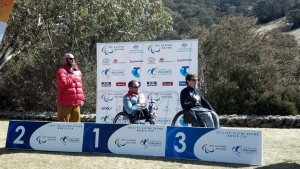 In 2006, he won the giant slalom World Cup title and then in 2009 and 2012, the downhill title. He considers the 2009 victory his favorite, because generally heavier people do better in that event. As the lightest skier in his category, Walker managed to win that year. “(In 2009), they had downhills that were very technical, so you had to turn a lot more than normal and you had to be at the right place at the right time,” Walker reflected. “And being small or more maneuverable, I was able to win a lot of key races. I never thought I would do well in that event.”
In 2006, he won the giant slalom World Cup title and then in 2009 and 2012, the downhill title. He considers the 2009 victory his favorite, because generally heavier people do better in that event. As the lightest skier in his category, Walker managed to win that year. “(In 2009), they had downhills that were very technical, so you had to turn a lot more than normal and you had to be at the right place at the right time,” Walker reflected. “And being small or more maneuverable, I was able to win a lot of key races. I never thought I would do well in that event.”
Walker is also a three-time X Games gold medalist, particularly excelling in the Mono-Skier X competition, which is essentially a race from the top of a mountain to the bottom with various rollers, jumps and gaps as obstacles. In addition to winning the event three times, he’s taken silver twice.
When Walker speaks at schools or camps, he’ll “try to explain to them, ‘If you want it badly enough, like if you want to be at my level doing something – it doesn’t have to be skiing – it takes a lot of time and commitment and the desire to be better than anyone else at what you do.’”
Walker’s actions since he began skiing at four years old more than back up his words. As his coach can attest to, Walker has never been satisfied with merely skiing; his goals have always been much loftier.
“Tyler’s the kind of person that when he puts his mind to something, he does anything he needs to do to accomplish (it),” said Jardine, who says “explorer” is the most fitting word to describe Tyler. “He wants to be able to prove that people with disabilities can accomplish things that people would never think of. We’ve had long conversations about different goals of his – he wants to ski every continent, he wants to be able to backcountry ski.”
Jardine recalled an instance when he saw Walker crawling up Highlands Bowl (Aspen, Colo.), a hill that takes able-bodied Jardine 45 minutes to hike.
“He’s willing to put himself through whatever it takes to experience what other people can experience, however rare it is, so it’s a pretty unique quality.”
Of course, Tyler is looking forward to competing at the 2014 Winter Paralympics in Sochi, Russia, next March, where he hopes to win his first Paralympic medal. After that, however, he says he’d like to “do something totally different just to reset my mind.”
Walker doesn’t yet know what he’ll do after Sochi, but judging from his lifelong ability to adapt to his circumstances, one would have to guess that he’ll figure it out pretty quickly.
Ever the explorer, it’s doubtful Walker will get lost.
 ATLX The only sports entertainment television and digital media network fully devoted to everyday athletes, athletic lifestyle and athletic culture.
ATLX The only sports entertainment television and digital media network fully devoted to everyday athletes, athletic lifestyle and athletic culture.
